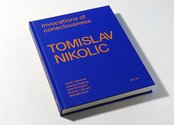John Hurrell – 15 January, 2024
These images, though smaller than life, are of colourful paintings that can be seen as a superbly inventive blend of Albers, Rothko and Hodgkin. They have great spatial and optical complexity, particularly with carefully positioned narrow planes of colour on the sides. That means frontal photography for a book like this will miss some aspects.
Tomislav Nikolic: Invocations of Consciousness
Sixty-five colour images of Tomislav Nikolic paintings (2009-2021), plus installation illustrations.
Texts by Justin Clemens, Juliana Engberg, Julie Ewington, Andrew Jensen and a conversation between the editors.
Edited by Tomislav Nikolic and Marielle Soni
Design by Luc Derycke and Jeroen Wille
Hardcover, 216 pp
MER, imprint of Borgerhoff and Lamberigts, Ghent, 2023
Regular long-term readers will know I’m a big fan of Tomislav Nikolic‘s painted wall sculptures (or sculptural paintings), works that—amongst other things-entice viewer movement, retinal concentration, analysis of concentric rectangles, contemplation of delicate planar surfaces, the undulating tactility of the intricately moulded ornate frames, and pondering details of nuanced painted edge. For this Nikolic project, enthusiasts sitting at home can now examine almost eighty-five perfectly sized pages—containing enlarged images—that are positioned in a thick, perfectly weighted, book. This very considered physicality (where you can choose the hue of your cardboard cover) enables the perusal of such photographic documentation to be effortless, as is the reading of five accompanying, linked-in, erudite essays and conversations.
This is because these images, though smaller than life, are of colourful paintings that can be seen as a superbly inventive blend of Albers, Rothko and Hodgkin. They have great spatial and optical complexity, particularly with carefully positioned narrow planes of chroma on the sides. That means frontal photography for a book like this will miss some aspects. Also, many colours are metallic and reflective by nature, with metal leaf and marble dust subtly incorporated. Where you stand in the gallery for a personal encounter, and how you move, in relation to the light source, is important.
Juliana Engberg kickstarts the discussion by drawing our attention to their pulsing groin-oriented sensuality with a gleeful dazzling blend of carnal and cerebral, optical, textural and spatial pleasures within the gallery space, that also dramatically celebrates their concentric planar movement.
In the longest and most factually informative contribution, Julie Ewington concentrates on various ‘Old Master’ historic paintings that have inspired Nikolic’s colour combinations. She examines very thoroughly certain works that the artist has mentioned, discovering chromatic connections in Bacon’s Two Studies from the Human Body (1974-75), Sassetta’s The Burning of a Heretic (c.1423-1426), Caravaggio’s Judith and Holofernes (c. 1599), Manet’s In the Conservatory (1878-1879), and two works from Mantegna: Parnassus (1496-1497) and Minerva Expelling the Vices from the Garden of Virtue (c.1500 -1502).
However, I’m not sure that this sort of information about the artist’s research is particularly valuable. After all a vast range of potentially useful colour juxtapositions can be discovered walking down any poster-lined inner-city lane, if the artist’s antennae are ready for them. Artists don’t need to go into galleries to discover helpful colour combinations, although such information when made public is good for the museum sector overall as it stimulates interest in art history, and it overtly enhances a sense of legitimacy and historical continuum for the paintings being produced. That is the cause of my discomfort. Unlike say the detritus which inspired the early collages of Picasso and Braque, it raises the status of these works as ‘high’ art, pulling these abstractions into a more easily marketable art historical narrative.
Justin Clemens’ sequence of very brief terse paragraphs—some single words-swirls around the notion of image recognition and other worldly mysticism-specifically the ontology of the objects as a gallery-friendly fine art form. Clemens briefly discusses pertinent theories from Hegel and Kant, kenosis from St. Paul, and the Buddhist preoccupation with nothingness.
Andrew Jensen elaborates on the metaphor of flight and weightlessness when describing the intensity of the viewer experience, when visually exploring these works. Personally he surprises me, as my own physical sense (my optical sensations) doesn’t cast me (my head-based mind and physical awareness) adrift from the rest of my body. In the gallery, my corporeal integration remains intact.
Interspersed with images, the artist’s conversation with the late Marielle Soni focusses on a perceived need for more open discourse within the Australian art community about various social and political issues, rather than an examination of Nikolic‘s paintings’ materiality: their physicality. For this reader, such a view is not wise or relevant, and can lead to polarisation (as is often the case) within the art community. Better perhaps to stick to palpable themes detectable within the constructed artefact, not wider, more divisive and fractious forums beyond the viewer’s body—that abandon material focus.
Nikolic‘s long titles are unusual. They often contain what seems to be a twisted undermining perversity, revelling in an unsettling paradox that mischievously pulls the carpet out from under chirpy reader expectations. Puzzling (polar opposite) philosophical elements are regularly blended together in terse captions that deliberately don’t quite add up. (Hints of Edmond Jabès.) Collectively however, these sometimes bizarre captions can make up a sort of collective poetry that when imagined as dense paragraphs, holds your interest, even when away from Nikolic‘s images.
Whatever the intentions behind his titles (if you think artist intentions matter), Nikolic‘s and Soni’s taped conversation, placed as separated fragments alongside images, seems specious, for it is the construction of the works as a corpus of beguiling objects with experiential substance, that really compel.
This alluring book, with its four excellent pleasurable essays, inevitably smooths over many contradictions. It celebrates a painting matrix of cleverly clustered sensualities and spatial types that aggressively barrel on down into the deeply receptive sensibilities of fortunate readers anyway.
John Hurrell




 Two Rooms presents a program of residencies and projects
Two Rooms presents a program of residencies and projects Advertising in this column
Advertising in this column



This Discussion has 0 comments.
Comment
Participate
Register to Participate.
Sign in
Sign in to an existing account.